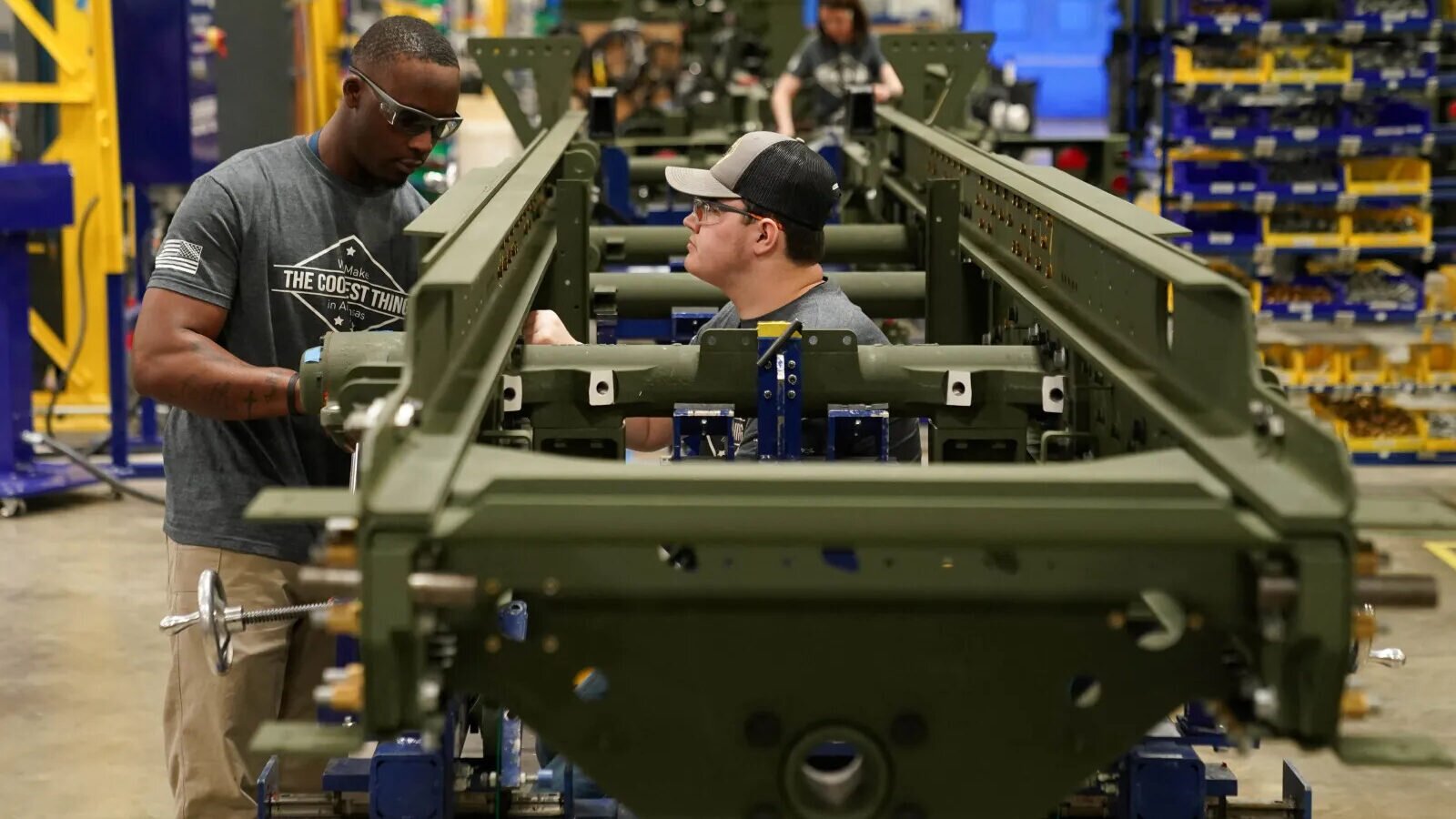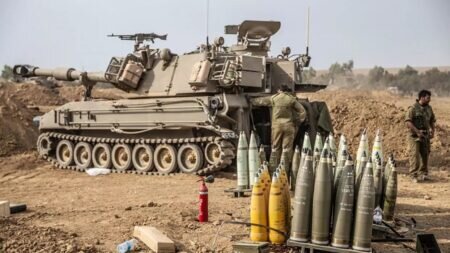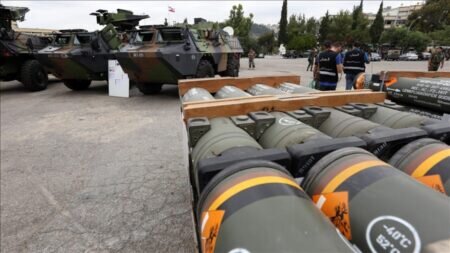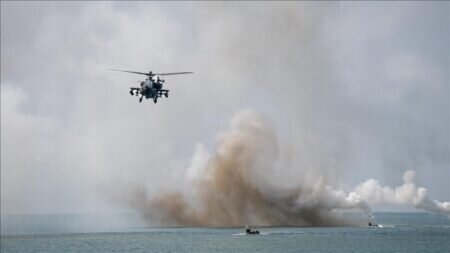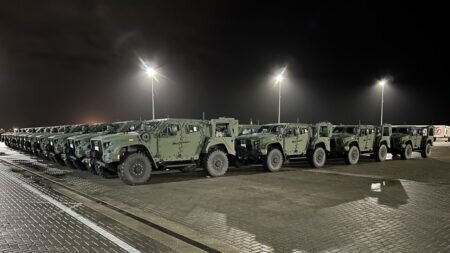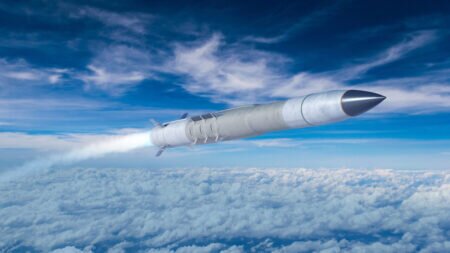After Russia invaded Ukraine in February 2022, the United States pledged its “unwavering support for Ukraine’s sovereignty.” This support has materialized in over $75 billion in security assistance to date, with the United States committed to aiding Ukraine until the fighting stops. As U.S. Secretary of State Antony Blinken said in announcing a new installment of weapons to Ukraine: “The United States and our allies and partners will stand united with Ukraine, for as long as it takes.”
These unlimited commitments to furnishing Ukraine with weapons to counter Russian aggression have invoked parallels to World War II. Weeks after the fighting began, New York Times columnist Paul Krugman argued that the United States and its allies are “serving as the ‘arsenal of democracy,’ giving the defenders of freedom the material means to keep fighting” in Ukraine. Journalist Elliot Ackerman then wrote that the workers building missiles for Ukraine’s defense “are a key component of America’s arsenal of democracy.” President Joe Biden has also embraced the “arsenal of democracy” analogy. When he visited a Lockheed Martin plant in Troy, Alabama, in May last year, Biden told the audience that the United States “built the weapons and the equipment that helped defend freedom and sovereignty in Europe years ago” and is doing so again today.
But this lofty rhetoric does not match the reality on the ground. Shortages in production, inadequate labor pools, and interruptions in supply chains have hamstrung the United States’ ability to deliver weapons to Ukraine and enhance the country’s defense capabilities more broadly. These problems have much to do with the history of the U.S. defense industry since World War II. Creeping privatization during the Cold War, along with diminished federal investment and oversight of defense contracting since the 1960s, helped bring about the inefficiency, waste, and lack of prioritization that are complicating U.S. assistance to Ukraine today.
After the Berlin Wall fell, major players in the U.S. defense industry consolidated and downsized their operations and labor forces. They also pursued government contracts for expensive, experimental weaponry to obtain larger profits to the detriment of small arms and ammunition production. As a result, the industry has been underprepared in responding to the Ukraine crisis and unmoored from the broader national security needs of the United States and its allies. Although reforms are possible, there are no quick fixes to these self-inflicted injuries.
THE WAY WE WERE
Today’s defense industry bears no resemblance to the U.S. system of military production during World War II. Back then, the industry was predominantly a government-run business. President Franklin Roosevelt’s New Deal emphasized economic regulation and relied on “alphabet agencies” such as the Works Progress Administration to boost employment, paving the way for later wartime contracting. New Deal agencies inspired the creation of the War Production Board in 1942, which mobilized business and rationed resources for the battlefront. Weapons production was concentrated in shipbuilding and aircraft, with companies based mainly in industrial centers in the Northeast and Midwest in government-owned, government-operated facilities known as GOGO plants. The government owned nearly 90 percent of the productive capacity of aircraft, ships, and guns and ammunition. This is in contrast to today’s climate, where commercial items have comprised over 88 percent of new procurement awards since 2011, and private capital invests over $6 billion a year in the defense industry.
When the Japanese bombed Pearl Harbor in 1941, federal control over defense production, and the Roosevelt administration’s rapid response to the attack, allowed speedy conversion from civilian to military production at companies such as Ford and General Motors, which went from making automobiles to bombers. Big companies were not the only ones to prosper. The federal government also looked to support small subcontractors that produced war-related materials in government-operated plants. Back then, no small group of powerful contractors dominated the industry, unlike today’s “Big Five”: Boeing, General Dynamics, Lockheed Martin, Northrop Grumman, and Raytheon.
Although the scale of weapons production for Ukraine is nowhere near equivalent to what was needed during World War II, that time period still provides valuable insight into today’s problems. As historian Mark Wilson has shown, the success of military mobilization during World War II—the ability to become an arsenal of democracy—required central planning and government control over industry. This is an essential lesson for those concerned with the U.S. defense industrial base and its ability to provide Ukraine and its allies additional weapons: government-mandated war production was required to provide the Allied powers with the requisite material they needed to defeat the Axis powers and end widespread unemployment created from the Great Depression—not private ingenuity alone.
BIG BUSINESS
The federal effort to spur employment through defense ended in the 1960s. Defense contractors lobbied Congress to relax government regulations to privatize the industry’s operations even before World War II ended. Defense mobilization during the Korean War revealed the growing power of private enterprise in U.S. military affairs. When war broke out in 1950, President Harry Truman relied on both executive orders and congressional legislation (including the 1950 Defense Production Act) to spur private—not public—investment in the military. As historian Tim Barker has pointed out, 90 percent of war production during the Korean War came from private finance.
After the Korean War, the federal government aimed to create jobs in the private defense sector and in universities working on Pentagon-funded projects; it did not focus on public employment. The federal government believed it had an obligation to create jobs to enhance a “cooperation with science and industry,” in the words of President Dwight Eisenhower. The U.S. government also sought to outcompete the Soviet Union in the space and arms race by growing the American labor force. Shocked by the Soviet launch of the Sputnik satellite in 1957, Eisenhower signed into law the 1958 National Defense Education Act, which provided government scholarships and loans to Americans pursuing secondary degrees (including doctorates) in science and technology related to the defense industry. The program raised the fortunes of the middle class, funding students in need who wished to pursue careers in defense. The National Defense Education Act enhanced the livelihoods of Americans, bringing thousands of Americans into the middle class, and setting a precedent for government to subsidize private job creation for the purposes of national security.
During the Kennedy and Johnson administrations, Secretary of Defense Robert McNamara instituted a series of reforms that both deemphasized the production of conventional weapons and closed large GOGO facilities. By the time U.S. military operations in Vietnam escalated into a full-fledged war in 1965, most defense installations were no longer government-owned, government-operated plants. In the years to come, the industry increasingly relied on government-owned, contractor-operated plants that gave companies more leeway to oversee their operations. The industry’s growing independence—and reduced accountability—led to a backlash during the Vietnam years. By the late 1960s, members of Congress, particularly William Proxmire, a Democratic senator from Wisconsin, were more vocal about the waste and abuse in the Pentagon budget. “It is discouraging for me, as a citizen and senator, to know that weapons cost far too much, are delivered far too late, and function far below their specifications,” Proxmire said in 1970. Still, Congress proved unable to enforce sustained regulations on the defense industry.
In the decades that followed, the rate of privatization and decline of congressional oversight only quickened. When cost overruns and fiscal management almost forced major companies such as Lockheed to near bankruptcy, defense companies complained of insufficient profits. After Vietnam, there was less pressure on Congress to scrutinize the industry, and the Department of Defense looked to help companies accumulate more profit by encouraging private investment in defense plants and weapons production that set the stage for the 1980s and 1990s.
THE LAST SUPPER
Vietnam was the last major conventional war for the U.S. defense industry. After the war ended in 1973 and the defense budget began to shrink, the industry shifted to foreign arms sales. The rise in arms exports to countries in the global South—from $404 million in 1970 to $9.9 billion in 1974—also coincided with deindustrialization and the outsourcing of defense manufacturing to foreign countries. This caused plant closures and job losses in domestic manufacturing in the United States. More defense parts were made overseas, and U.S. defense manpower declined by 9.8 percent from 1960 to 1975. Areas of the United States like New England saw a 50 percent decrease in civilian and military personnel.
By the 1980s, both the Pentagon and Congress grew increasingly concerned with the overall weaknesses of the defense industrial base. Lawmakers feared that the United States’ “mushrooming dependence on foreign sources,” according to Democratic Representative Richard Ichord of Missouri, would imperil defense preparedness. In 1988, the Pentagon warned that “in a national emergency, the consequences of extensive dependence on foreign sources could be extreme.”
Although President Ronald Reagan pursued a defense buildup, growing spending from $176.6 billion in 1981 to $325.1 billion in 1990 (defense spending climbed to over six percent of GDP between 1982 and 1988), he failed to address these concerns. Instead, defense spending under Reagan prioritized experimental projects such as the MX missile and the Strategic Defense Initiative, a proposed missile defense system that would protect the United States from nuclear attack. Nicknamed the “Star Wars” program, it cost the U.S. government $30 billion before President Bill Clinton canceled it in 1993. The Reagan administration also poured money into advanced aircraft such as the B-2 stealth bomber and the F-22 stealth fighter over other less glamorous purchases of artillery and ammunition.
Reagan also failed to properly modernize defense plants in the United States and revive the manufacturing workforce in the defense sector. The largest defense companies fared the best under Reagan. By 1987, Paul Burnsky of the AFL-CIO warned Congress that “American companies that formed the core of the U. S. defense … are finding little support from the Reagan Administration. Many have gone bankrupt, particularly the subcontractors in the small business community.” Other subcontractors found defense business to be less than lucrative in the 1980s and shifted to other sources of revenue. The Reagan buildup also coincided with an antigovernment ethos that permeated American politics and shaped the decisions on national defense made by both Democrats and Republicans. This ethos even shaped defense acquisition reform in the 1980s. When reporters uncovered rampant waste and abuse within the procurement process— including the discovery that the Navy was paying $600 for toilet seats —the 1986 Packard Commission criticized government inefficiency as the source of the problem. “The nation’s defense programs lose far more to inefficient procedures than to fraud and dishonesty,” wrote the commission. A faith in free trade, cost cutting, and “efficiency” also expedited defense outsourcing, enabling the defense industry to continue to shed American workers. Indeed, the U.S.-based defense workforce would reach its height in the 1980s with 3.2 million people, consistently declining to the present day number of 1.1 million.
When the end of the Cold War led to a discussion of a “peace dividend,” and U.S. policymakers began reevaluating how much to spend on defense, military contractors felt they had to make a choice: consolidate or perish. At an infamous 1993 dinner at the Pentagon, which is known among industry insiders as “The Last Supper,” Pentagon leaders warned the CEOs of the country’s biggest defense companies that the defense budget was about to fall precipitously. Deputy Secretary of Defense William Perry told them, “We expect defense companies to go out of business. We will stand by and watch it happen.”
Contractors got the message and began consolidating. Mergers went from being valued at $300 million in 1990 to $20 billion by 1996. The number of contractors for tactical missiles went from 13 to three, and for fixed-wing aircraft, the number went from eight to two. Clinton hoped consolidation would lower costs and streamline the contracting process. Neither materialized. Thousands of jobs were lost, and the Clinton administration offered meager assistance to those newly out of work.
Although defense spending surged again after 9/11, little changed in the defense industry. Consolidation continued to grow during the “war on terror” and has now reached record numbers due the influence of private equity firms. Indeed, recent statistics indicate more than 500 companies have been bought out by private equity in the last two decades, which has lent further instability and unaccountability to defense acquisitions. The high rate of debt held by private equity firms, their lack of accountability to public oversight, and their higher risk of default do not serve U.S. national security interests. In addition to the role of private equity, proliferation of Silicon Valley–based defense startups over the past several years has promised innovation and the modernization of the defense industrial base. But those promises have yet to materialize.
Meanwhile, defense contractors have continued to pursue big-ticket items over purchases of lower-cost munitions. For example, the F-35 Joint Strike Fighter program is estimated to cost $1.6 trillion from start to finish. The production of small parts—rocket motors, ball bearings, tubes, steel casings, and other materials essential for the Ukrainians—is not as profitable and, until recently, had less importance for both the U.S. government and defense contractors. Parochial politics and lobbying have also skewed the Pentagon’s priorities and forced the military to maintain contracts for obsolete programs such as the littoral combat ship. As Undersecretary of Defense William LaPlante told Eric Lipton of The New York Times in March, “[The United States] really allowed production lines to go cold and watched as parts became obsolete.” Despite this, the industry continues to chase investment in high-cost advanced aircraft and missiles such as the B-21 stealth bomber and the LGM-35 Sentinel intercontinental ballistic missile, even though these types of programs predictably lead to widespread delays and cost overruns, which American taxpayers have to cover.
THE HOME FRONT
This 70-year history of consolidation, privatization, outsourcing, job cuts, federal inaction, and a hunt for larger profits has created a perfect storm that now hobbles security assistance for Ukraine, and potentially for future conflicts, as well. As reported in Politico and The Wall Street Journal, the United States does not have the necessary labor force to produce the number of Javelin missiles requested by Ukraine, even after Ukraine burned through a putative five-year supply of Javelins in the first six months of the war. It also consumed what was meant to be a six-year supply of Stinger missiles in just ten months. One of the few U.S. government-owned, contractor-operated plants that produced the black powder needed for artillery rounds exploded in 2021 and was never rebuilt because it could not generate enough profit. Interruptions in global supply chains are also expected to plague the defense industry for the foreseeable future. Although the industry expects increased sales and profit margins over the next year, long-standing backlogs, supply disruptions, and cost overruns remain.
The United States cannot rectify these problems in the short term or reverse this history overnight. Comprehensive solutions require government involvement and stronger control over the industry in the immediate and long terms. Defense reform must go beyond acquisition or auditing—although changes are needed on both fronts. Congress must reimagine defense reform, drawing lessons from the last time the United States truly was an arsenal of democracy. A key takeaway from this time is that greater federal intervention in the defense industry is needed if the industry is to produce otherwise “unprofitable” weapons.
Signs of comprehensive bipartisan defense reform are on the horizon. Senator Elizabeth Warren, a Democrat from Massachusetts, has spearheaded legislation that takes on consolidation and monopolization, and her efforts are supported by some Republicans, such as Senator Chuck Grassley, a Republican from Iowa. Their efforts are laudable given that the numerous subcontractors that proved essential to winning World War II do not exist today because they cannot compete with the monopoly power of the “Big Five.”
The preeminent concern among analysts has been how to replenish stockpiles of weapons to ensure the United States does not deplete its overall arsenal. But stockpiling weapons is impossible given the dearth in skilled American labor. Defense contractors have struggled to recruit workers for years in an industry that often requires vocational training or two-year degrees from its employees. Educating and training future defense workers takes time—time that Ukraine does not have at the moment. Weapons production cannot be willed into existence. To achieve a more stable, trained workforce, the United States must support job creation across all employment sectors, not just defense, so that Americans have the requisite skills and training needed in times of crisis. Biden is attempting to address this with the CHIPS and Science Act, which he signed into law in 2022. The impetus for the new law is the United States’ competition with China, and the legislation sponsors grants and loans to students pursuing careers in STEM fields. But the Biden administration can go beyond the program and pursue additional policies that subsidize higher education and job creation in peacetime—to revitalize struggling post-industrial cities that are involved in aiding Ukraine’s defense but will surely experience economic downturns when the war ends, such as Camden, Arkansas, or Troy, Alabama, where over 25 percent of the population lives below the poverty line. The United States should expand its workforce for the long term, for the health of its own democracy, not just for its national security interests related to Russia and China.
This is particularly important given the historical reluctance of the industry to diversify its operations or to quickly adapt to the needs of American troops engaged in conflict. During the wars in Iraq and in Afghanistan, U.S. soldiers regularly faced shortages in equipment and ammunition. This had much to do with the fact that, by 2004, only one plant in Missouri produced ammunition for the entire U.S. military, down from five during the Vietnam War, plus there was only one manufacturer of protective body armor. For years, the industry—supported by the Pentagon—has tried to do more with less, to consolidate its operations then ramp up production in times of crisis. But this strategy has not worked for the United States in the past, and it is currently not working for Ukraine.
The United States cannot be an arsenal of democracy to Ukraine, or to any country, if it does not better align its foreign and domestic policies in ways that improve the lives of American citizens. To better serve Ukraine, the United States must invest more in Americans’ futures, not just in its own defense capabilities.
Source: By Michael Brenes, Foreign Affairs

